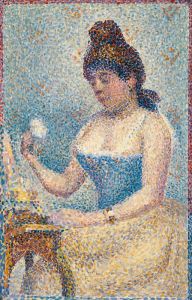
Bathers
A hand-painted replica of Georges Seurat’s masterpiece Bathers, meticulously crafted by professional artists to capture the true essence of the original. Each piece is created with museum-quality canvas and rare mineral pigments, carefully painted by experienced artists with delicate brushstrokes and rich, layered colors to perfectly recreate the texture of the original artwork. Unlike machine-printed reproductions, this hand-painted version brings the painting to life, infused with the artist’s emotions and skill in every stroke. Whether for personal collection or home decoration, it instantly elevates the artistic atmosphere of any space.
"Bathers by Georges Seurat," also known as "Bathers at Asnières," is an iconic painting by the French artist Georges Seurat, completed in 1884. This work is a significant example of the Neo-Impressionist movement, which Seurat helped to pioneer. The painting is notable for its innovative use of color and light, as well as its depiction of modern life.
The painting measures approximately 201 cm by 300 cm and is executed in oil on canvas. It is currently housed in the National Gallery in London. "Bathers at Asnières" depicts a group of young men relaxing by the Seine River in the Parisian suburb of Asnières. The scene captures a moment of leisure, with figures lounging on the riverbank, some seated, others lying down, and one figure in the water. The setting is industrial, with factories and smokestacks visible in the background, contrasting with the serene foreground.
Seurat's technique in this painting is particularly noteworthy. He employed a method known as Divisionism or Pointillism, which involves applying small, distinct dots of color to the canvas. This technique allows the viewer's eye to blend the colors optically rather than physically mixing them on the palette. Although "Bathers at Asnières" is not as fully realized in Pointillism as Seurat's later works, it marks an important step in his development of the technique.
The composition of "Bathers at Asnières" is carefully structured, with a strong sense of balance and harmony. Seurat was influenced by classical art and sought to bring a sense of order and stability to his work. The figures are arranged in a way that guides the viewer's eye across the canvas, creating a rhythmic flow. The use of horizontal and vertical lines adds to the sense of calm and tranquility.
Seurat's choice of subject matter reflects the social changes occurring in France during the late 19th century. The industrial backdrop highlights the rapid urbanization and industrialization of Paris, while the leisurely activities of the figures suggest the growing importance of leisure time in modern life. This juxtaposition of industry and leisure is a recurring theme in Seurat's work.
"Bathers at Asnières" was first exhibited at the Salon des Indépendants in 1884, an exhibition organized by artists who were not accepted by the official Paris Salon. The painting received mixed reviews at the time, with some critics praising its innovative technique and others dismissing it as too radical. Despite the initial criticism, Seurat's work has since been recognized as a groundbreaking contribution to modern art.
The painting's influence extends beyond its immediate impact on the art world. It has been studied for its technical innovations and its exploration of contemporary themes. Seurat's approach to color and composition has inspired countless artists and continues to be a subject of scholarly interest.
In summary, "Bathers by Georges Seurat" is a masterful representation of the Neo-Impressionist movement, showcasing Seurat's pioneering techniques and his engagement with the social and industrial changes of his time. The painting remains a celebrated work in the history of art, admired for its beauty, complexity, and historical significance.


















